Joensuu 作者: 来源: 发布时间:2021-10-14
一、所属省或是州,具体位置,人口,面积
Joensuu (Finnish pronunciation: is a city and municipality in North Karelia, Finland. It was founded in 1848. The population of Joensuu is 76,543 (January 31, 2019), and the economic region of Joensuu has a population of 115,000. The nearest major city, Kuopio in North Savonia, is located 136 kilometres (85 mi) to the west. As is typical of cities in Eastern Finland, Joensuu is monolingually Finnish.
Joensuu is a lively student city with a subsidiary of the University of Eastern Finland, which has over 15,000 enrolled students, and a further 4,000 students at the Karelia University of Applied Sciences. The largest employers are the municipal City of Joensuu, North Karelian Hospital District Federation of Municipalities, Abloy and Punamusta. The European Forest Institute, the University and many other institutes and export enterprises such as Abloy and John Deere give Joensuu an international flavour.
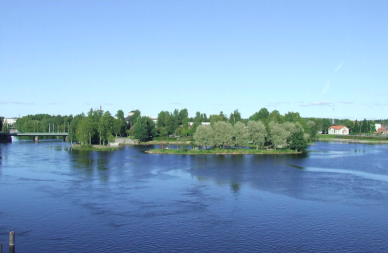
https://www.joensuu.fi
二、自然地理
1.地理条件
The principles of the cityscape of Joensuu were created in the first town plan drawn up by architect Claës Wilhelm Gyldén in 1848. It shows the division of the city into regular-sized rectangular blocks, which were initially divided into six plots. The Gyldén town plan represents the zoning ideals of the empire, with an emphasis on promoting fire safety by dividing the city through wide park streets that slow the spread of fire. This ideal culminated in the General Urban Building Order (KYRJ) of 1856.
The city center is in bold. Agglomerations marked with an asterisk only partially belong to this city. In addition to Joensuu, the city center of Joensuu extends partly to the municipalities of Kontiolahti and Liperi. Joensuu's city center has a total of 71,798 inhabitants and an area of 80.17 square kilometers. The bowl settlement extends mainly to the territory of the municipality of Kontiolahti. Of the agglomerations defined in 2017, Reijola has grown together with the Joensuu city center in the 2018 agglomeration delimitation.
Joensuu has a subarctic climate (Köppen: Dfc) due to its high latitude and inland position. Being quite far inland, Joensuu has a more continental climate than most of Finland. As a result, Joensuu can be prone to temperature extremes both in winter and summer. For example, Joensuu is on average warmer than Dublin or Manchester in July, and colder than Moscow in January. Winters are long, cold and snowy. Summers however, bring frequent temperatures above 20.0°C (68.0°F) and thunderstorms occur typically on 10–15 days per year. An all-time record of 37.2°C (99.0°F) on July 29, 2010, is also the Finnish nationwide heat record. The coldest temperature ever recorded in Joensuu was −40.0°C (−40.0°F) on December 10, 1955. In winter, the snowcover is reliable and on average 50–70 cm deep. Annually, Joensuu experiences on average 24 days with temperatures −20°C (−4°F) or colder while temperature below −30°C (−22 F) is observed about once per year. Annual total precipitation averages at 589 mm, with about 225 mm of it falling in the form of snow.
https://www.joensuu.fi
2.交通情况
Joensuu has a railway station and a bus station, which offers intercity connections to Helsinki and local connections to several other places. Numbered bus service is available to all parts of Joensuu (Route maps, Timetables). Note, that if you want to catch a bus, you have to wave at the driver - the bus does not stop automatically. Joensuu also has an airport, with flights to Helsinki. Joensuu is located along the Blue Highway, which is an international tourist route from Mo i Rana, Norway to Pudozh, Russia via Sweden.
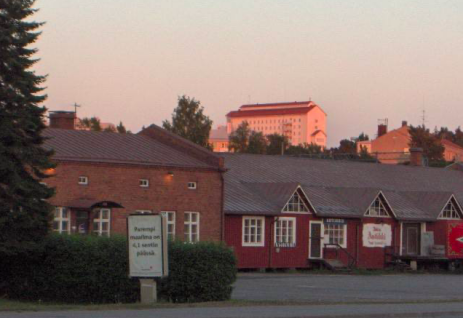
This photo shows a railway station warehouse in the foreground, the wooden wall of which burned to the ground in arson in 2012. In the background, Niinivaara and the Central Hospital. Joensuu is an important railway junction. VR's long-distance traffic transports passengers south of Joensuu (Joensuu – Lappeenranta – Lahti – Helsinki), west (Joensuu – Pieksämäki) and north (Joensuu – Nurmes). The track leading to Ilomantsi also had regular passenger traffic on an experimental basis from 1967 to 1969. Since then, there has been only regular freight traffic on the track, especially timber transport. The Ilomantsi track was renovated in the 2010s due to the needs of the industry.
Joensuu night train services were canceled during the first three days of September 2006. So far, the last night train departing from Joensuu took place in Turku on Friday, September 1, 2006 at 11.07 pm. At least for the Joensuu-Helsinki train connections, service level improvements can be expected in the coming years, as the government program published on 3 June 2019 has decided to include the “line east of Helsinki” among the three flagship projects of the railway network. In the spring of 2020, Joensuu Region Public Transport (JoJo) will be served by a total of 18 permanent local transport lines, of which fourteen (14) will be operated by Savo-Karjalan Linja Oy and four by Savonlinja Oy as a result of the latest tender. In addition to the city of Joensuu, JoJo traffic extends to the municipalities of Kontiolahti and Liperi.
Joensuu Airport is located in the municipality of Liperi, 11 km northwest of the center of Joensuu. There is a direct flight connection from Joensuu to Helsinki, where Finnair flies 3–5 flights a day. Inland waterway traffic is mainly served by the Ukonniemi deep harbor in the Penttilä district and the passenger harbor in the city center. Joensuu is the most important hub for road traffic in North Karelia. The city is bypassed by a 26-kilometer highway, which was completed in its entirety in late summer 2014.
https://www.joensuu.fi
三、经济发展和规模
The income tax rate of the City of Joensuu in 2019 is 20.5%. Joensuu is a growing provincial center with a service-oriented business life. The concentration of information and communication technology companies has taken place in the premises offered by the Joensuu Science Park. Major industrial companies include lock manufacturer Abloy, forest machine manufacturer John Deere. Research and product development in Joensuu is held at the university, science park, METLA and a few companies in areas such as color research and diffractive optics.
Jobs by industry (2002):
Social services 40.6%
Industry 15.8%
Trade, accommodation and restaurant activities 15.7%
Financial, insurance and other activities 12.1%
Transport, storage and communication 7.5%
Construction 5.2%
Unknown 1.3%
Electricity, gas and water supply 1.1%
Agriculture, game, forestry and fishing 0.6%
Mining and quarrying 0.1%
The unemployment rate in Joensuu on 31 December 2018 was 14.7% [24] Largest employers in 2006: City of Joensuu (4,409 employees), North Karelia Hospital District Consortium (2,220), University of Joensuu (1,244), Abloy Oy (800), North -Karelia Education Consortium (537), North Karelia Cooperative (512), VR companies (430), North Karelia Printing Corporation (317) and Schauman Wood Oy (292).
In the 2010s, the Palkeet Agency and the Finnish Defense Forces Service Center were established in Joensuu.
https://www.joensuu.fi
四、产业特点/重点项目
The companies that paid the most corporate tax in 2015 were Broman Group Oy, which sells car spare parts and accessories, the key company Assa Abloy Oy, the North Karelia Cooperative, E. Hartikainen Oy, which operates in the construction and car business areas, and Autokiinteistöt Laakkonen Oy.
https://www.joensuu.fi
五、风景名胜,景点( attractions)
1. Shrines
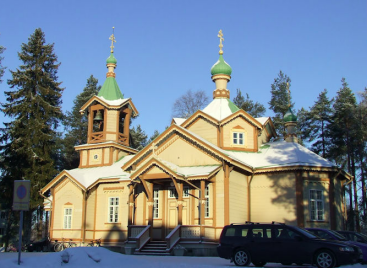
The Evangelical Lutheran and Orthodox main churches are at opposite ends of Kirkkokatu, which runs through the center of Joensuu, and at the same time on opposite sides of the center, ie the grid area. The churches of the East and the West seem to look at each other across the city.
At the southern end of Kirkkokatu, on a small hill, is the Lutheran main church, Joensuu Church, which represents the neo-Gothic style. There are also four other Lutheran churches in the agglomeration: Pielisensuu Church in Niinivaara, Noljaka Church, Rantakylä Church and Utra Wooden Church.
At the northern end of Kirkkokatu, on a small hill, is the main church of the Joensuu Orthodox Parish, the Church of St. Nicholas. St. Nicholas Church is a traditional northern Russian Orthodox church that has used a lot of wood and was completed in 1887. There is also another Orthodox church in Joensuu; Orthodox Seminary Church of St. John the Theologian with Byzantine architecture.
In addition to these, the city of Joensuu has new areas, including a dozen significant Lutheran and Orthodox shrines, as well as a mosque. Literature: God's Tent Among the People: Churches and Chapels of the Evangelical Lutheran Congregations in Joensuu. 2003.
https://www.joensuu.fi
2.Snowshoe Tour
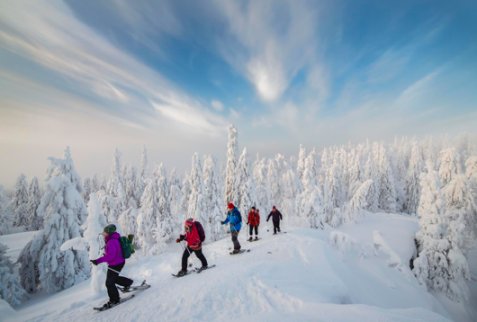
Guided snowshoe tour to the wintry forests of Koli, to the best scenic places and ice falls. On the tour, your guide tells you about Koli, its nature, history and cultural history. The pace its relaxed, there is plenty of time to enjoy the winter nature. The price includes hot juice and a light snack. This tour is organised by advance booking, bookings should be made at least 48 hours before the tour. The minimum number of participants is two persons.
A walking tour to the best scenic viewpoints of Koli safely on snow spikes! On the tour you wear snow spikes designed for professional use which fit on top of your own shoes. The walking pace on the tour is relaxed and there is plenty of time to enjoy the wintry nature and listen to stories about Koli. This tours in organised by advance booking, bookings should be made at least 48 hours before the tour. The minimum number of participants is two persons.
https://www.joensuu.fi
https://www.visitkarelia.fi/en/Frontpage--
3. Kitee Zoo
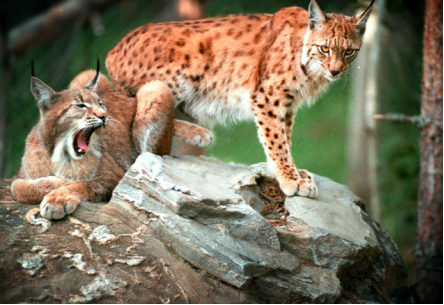
In Kitee, the fourth largest zoo in Finland, you can explore 50 different species of animals along the landscape path, such as yaks, Ayam gemani chickens and the Riku bear. Right next to the animal park there is a hotel, cottages, restaurant, dance pavilion, shop and Spa. Kitee Zoo is open all year round. The path of two kilometers will give you an experience filled with beautiful scenery and interesting animals. The zoo offers you a chance to meet 50 different species (around 200 individuals). Among them are the lynxes, yaks, deer, alpacas, reindeer, wild boars and the king of the forest, Riku-bear. Birds have a significant role in our zoo too.
Our zoo was founded in 1996 and expanded in 1997. Current area is 10 hectares. Our aim is to continuously develop and reinforce the zoo to keep it interesting and make it even better. For example, in the summer of 2017 our zoo gained quite a few new residents as Père David’s deer aka milu, a couple of white peacocks, a family of Gouldian finches and a pair of sables arrived to their new home. The year 2018 began with the arrival of Ayam Gemani -chickens. They are quite a special species, since they are all black. Feathers, flesh, bones, combs, feet – everything fits the dark theme! The species has made its way to our zoo all the way from India.
Kitee zoo is located in the region of the Tourist Centre Pajarinhovi. The distance from Kitee city is 15 kilometres. It’s easy to visit us, since we are located right next to highway 6. The closest train station is just 15 minutes drive away, too. Right next to the zoo are the hotel, cottages, restaurant, dance pavilion, shop and spa.
https://www.joensuu.fi
https://www.visitkarelia.fi/en/Frontpage--
https://kiteezoo.fi/en/
六、历史文化
1.历史
The city of Joensuu, founded by the Czar Nicholas I of Russia in 1848, is the regional centre and the capital of North Karelia. During the 19th century Joensuu was a city of manufacture and commerce. When in 1860 the city received dispensation rights to initiate commerce, former restrictions against industry were removed and the local sawmills began to prosper and expand. Water traffic was improved by the building and opening of the Saimaa Canal in 1856. Consequently, a lively commerce between the regions of North Karelia, St. Petersburg and Central Europewas enabled. At the end of the 19th century Joensuu was one of the largest harbour cities in Finland.
Throughout the centuries Karelian traders have plied the Pielisjoki River. The river has always been the lively heart of the city. Canals – completed by 1870 – increased the river traffic. Thousands of steamboats, barges and logging boats sailed along the river during the golden age of river traffic. The Pielisjoki River has also been an important log raft route, providing wood for the sawmills and for the entire lumber industry.
During the last few decades, the formerly modest agrarian town has developed into a vital centre of the province. Success in regional annexations, the establishment of the province of Karelia and investments in education have been the most decisive actions in this development. The municipality of Pielisensuu was consolidated with Joensuu in 1954. At the beginning of 2005, the municipalities of Kiihtelysvaara and Tuupovaara were consolidated with Joensuu. At the beginning of 2009 the municipalities of Eno and Pyhäselkä were consolidated with Joensuu. After the most recent consolidations, there are approximately 73,000 inhabitants in the Joensuu municipal area.
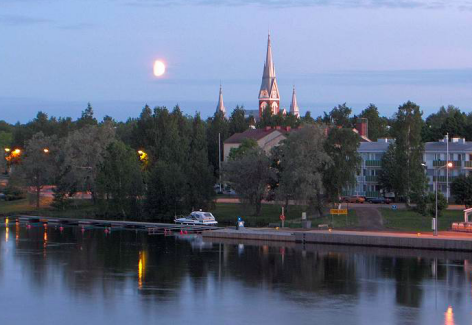
The central church of Joensuu is renowned for its sharply augmented towers, which in this image are tinged by the midnight sun and with a moonrisein the background. The University of Joensuu (now part of the University of Eastern Finland since January 2010) has, in twenty-five years, expanded to eight faculties. The university is one of the mainstays for the vitality of the city and so for all North Karelia. Diversified international cooperation in science, industry and commerce benefits the whole region. The proximity of the eastern border has been an important factor in the history of the city. The Republic of Karelia is once again a significant area for cooperation with nearby regions in Russia. Export companies in Joensuu continue the pre-revolutionary traditions in foreign trade.
Joensuu offers varied cultural activities. A series of events – Ilosaarirock festival, Joensuu Music Winter, Festival of Visual Culture Viscult, Gospel festivals – and the unspoilt environment increase the attractiveness of the city. Joensuu is sometimes referred to as the Forest Capital of Europe, mainly because the European Forest Institute is based there. Other forestry research and educational facilities are also based in Joensuu.
https://www.joensuu.fi
2. 文化体育
Joensuu is a city of students. The University of Eastern Finland (UEF) has one of its three main campuses in Joensuu and the University of Applied Sciences Karelia has two Joensuu campuses. The headquarters of the Joensuu Region Citizens' College. The house designed by Wivi Lönn now also houses the high school of Joensuu Co-educational School. The building has been continued e.g. with a new part designed by Pasi Siistonen, completed in 2015. The universities operating in Joensuu are the University of Eastern Finland and Karelia University of Applied Sciences. About 7,700 students study on the Joensuu campus of the University of Eastern Finland, and about 4,000 at the University of Applied Sciences - some of them in the branches of schools in other cities.
Music is an important part of Joensuu's cultural life. Of the well-known Finnish rock bands, Hassinen's Kone and Neljä Ruusua, among others, are from Joensuu. The leading characters of these bands are Ismo Alanko (Hassisen Kone) and Ilkka Alanko (Four Roses) are today the most famous people from Joensuu. The university and other educational institutions have created Joensuu as a city of culture. The University of Eastern Finland has several humanities, arts-related and traditional studies education lines, and Karelia University of Applied Sciences has degree programs in visual arts, handicrafts, design, graphics and many media. The city also has a conservatory and the Pekkala School of Fine Arts.
The city is known for its basketball club Kataja, which plays in the Finnish first-tier league Korisliiga. Other championship level clubs of Joensuu include Josba (floorball), Mutalan Riento (volleyball), the world leading orienteering club Kalevan Rasti (orienteering) and Joensuun Prihat (women's volleyball). The ice hockey team Jokipojat plays in the Finnish second-tier league Mestis, and their home arena is the Mehtimäki Ice Hall. The local football club Jippo plays in the Finnish second Division. Finnish baseball enjoys popularity as well and the local team, Joensuun Maila, plays in the top division Superpesis.
Notable sportspeople from Joensuu include Jukka Keskisalo, the European champion in 2006 at 3000m St., and Aki Parviainen, the world champion of Javelin throw in 1999; biathlete Kaisa Mäkäräinen, who won three overall World Cup titles in the 2010–11, 2013–14 and 2017–18 seasons; 1983 WRCchampion Hannu Mikkola; 2013 GRC champion and current World RX driver Toomas Heikkinen; and NHL ice hockey players Urho Vaakanainen and Juuso Riikola.
https://www.joensuu.fi
七、其他信息
The most significant buildings completed in the 21st century are the Joensuu Arena, which when completed in 2003 was the largest wooden building in Finland, and the Metla House of the Finnish Forest Research Institute, which when completed in 2004 was the largest wooden office building in Finland.
Since the middle of the first decade of the 21st century, the city center has been briskly built. Plenty of new commercial buildings were added to the market area, the new administration building of the university campus Aurora II was completed, Joensuu Science Park has received additional buildings, and a new Lyseo primary school building was completed in 2007 to replace the demolished Lyseo primary school. The Iso Myy shopping center was completed in its entirety in the autumn of 2007, covering more than 70 stores. Old shopping centers, such as the Metropolia Shopping Center and Centrum, have also been renovated and expanded. Above the street between Iso Myy and the Metropolis is a bridge connecting the shopping centers. There are many shopping malls and shopping parks in Joensuu with supermarkets. For example, on Voimatie, in the area of the Joensuu shopping park, there is Prisma, and other massive department stores. There are 13 S-markets in the city of Joensuu. A third K-citymarket has been planned for Karsikko in Joensuu.
https://www.joensuu.fi
八、联系方式
Town manager: Kari Karjalainen
Phone: 013 267 7111
Email: kirjaamo@joensuu.fi
Address: PL 59, 80101 JOENSUU
https://www.joensuu.fi
https://www.visitkarelia.fi/en/Frontpage--
